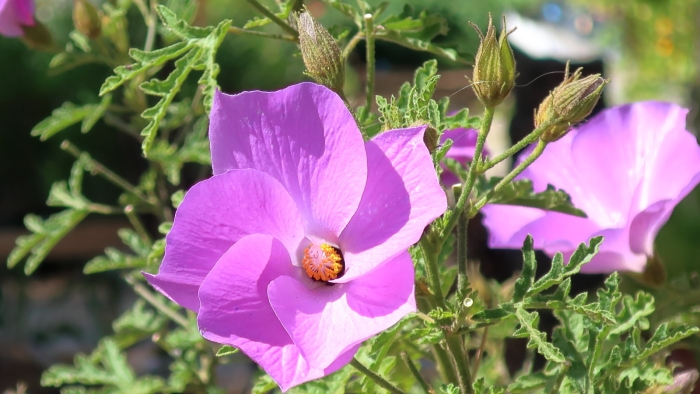Lilac Hibiscus
(Hibiscus huegelii)
Lilac Hibiscus (Hibiscus huegelii)
/
/

cultivar413
CC BY 2.0
Image By:
cultivar413
Recorded By:
Copyright:
CC BY 2.0
Copyright Notice:
Photo by: cultivar413 | License Type: CC BY 2.0 | License URL: https://creativecommons.org/licenses/by-sa/2.0/ | Uploader: cultivar413 | Publisher: Flickr |

















Estimated Native Range
Summary
Hibiscus huegelii, commonly known as Lilac Hibiscus, is an evergreen shrub native to coastal shrublands and heathlands, as well as sandy plains in Southern and Western Australia. It can grow up to 4 meters in height and has a bushy habit with many alternate branches, though the lower ones may be sparse. The bright green leaves are deeply lobed, with three to five segments, giving them a distinctive appearance. The flowers are large and showy, with colors ranging from cream to mauve or lilac, blooming from spring to summer. The plant’s flowers are particularly attractive to pollinators such as bees and birds.
Lilac Hibiscus is valued for its large, showy flowers and ability to thrive in coastal conditions. It is often used in residential landscapes, as a feature plant in mixed borders, or as informal hedging. This shrub is drought-tolerant once established, making it suitable for water-wise gardens. It prefers full sun but can tolerate light shade and requires well-drained soils. While it is adaptable to a range of soil types, it performs best in sandy soils. Regular pruning can help maintain a compact form and encourage more prolific flowering.CC BY-SA 4.0
Lilac Hibiscus is valued for its large, showy flowers and ability to thrive in coastal conditions. It is often used in residential landscapes, as a feature plant in mixed borders, or as informal hedging. This shrub is drought-tolerant once established, making it suitable for water-wise gardens. It prefers full sun but can tolerate light shade and requires well-drained soils. While it is adaptable to a range of soil types, it performs best in sandy soils. Regular pruning can help maintain a compact form and encourage more prolific flowering.CC BY-SA 4.0
Plant Description
- Plant Type: Shrub
- Height: 4-8 feet
- Width: 4-6 feet
- Growth Rate: Moderate
- Flower Color: Purple
- Flowering Season: Summer, Fall
- Leaf Retention: Evergreen
Growth Requirements
- Sun: Full Sun
- Water: Low, Medium
- Drainage: Slow, Medium, Fast
Common Uses
Bee Garden, Bird Garden, Border Plant, Butterfly Garden, Deer Resistant, Drought Tolerant, Hedges, Hummingbird Garden, Low Maintenance, Salt Tolerant
Natural Habitat
Native to coastal shrublands and heathlands, as well as sandy plains in Southern and Western Australia
Other Names
Common Names: Blue Hibiscus
Scientific Names: , Alyogyne huegelii, Hibiscus huegelii, Hibiscus pinonianus, Hibiscus geranifolius, Hibiscus grossulariifolius, Hibiscus huegelii var. glabrescens, Hibiscus huegelii var. wrayae, Hibiscus huegelii var. angulatus, Hibiscus huegelii var. grossulariifolius
GBIF Accepted Name: Hibiscus huegelii Endl.